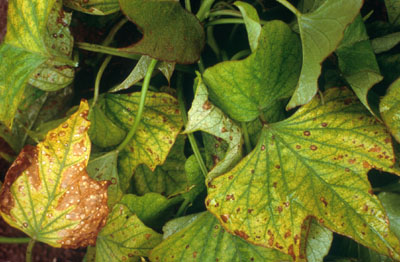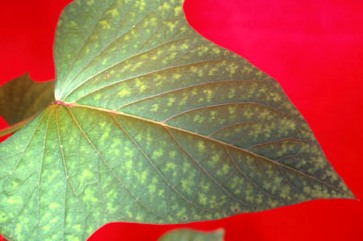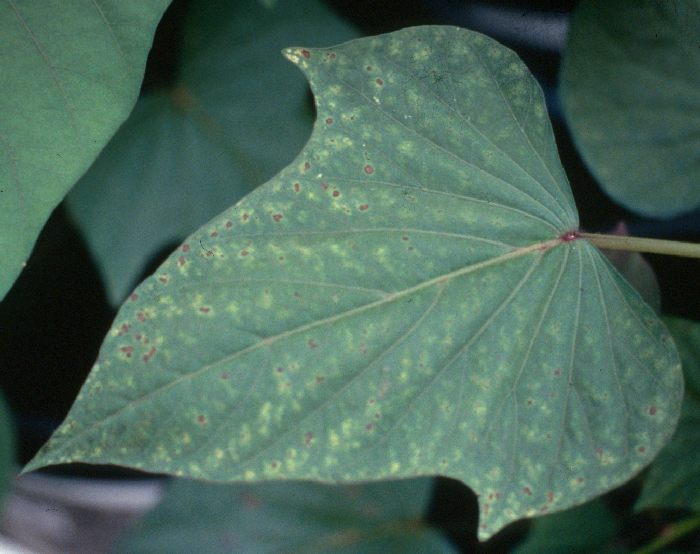|
Manganese
(Mn) is frequently an abundant constituent of soils, but its low solubility at
neutral and alkaline pH
prevents excessive uptake by plants. Therefore, manganese toxicity
is nearly always associated with acid soils.
Waterlogging may also induce or exacerbate manganese toxicity, as anaerobic
conditions cause higher oxides of manganese to be reduced to plant-available Mn2+.
Thus in some instances manganese toxicity may appear during wetter periods, with
plants recovering as the soil dries out. Manganese is also a component of some
fungicides, and may accumulate through repeated use of these fungicides,
especially to crops grown on sandy soils.
Like boron toxicity, manganese toxicity causes necrotic
spots to appear on the older leaves of
the vine. Manganese toxicity also frequently causes chlorosis (pale or yellow
colour), most severe on the younger leaves, due to an induced iron deficiency.
Either one or both of these symptoms may be observed in crops affected by
manganese toxicity.
Symptoms on older leaves begin with the appearance of small,
irregularly shaped patches of pale tissue in interveinal
zones. The pale tissue is slightly sunken, and small (0.5 - 2
mm), roughly circular spots of dark necrosis soon develop. The necrotic spots
are usually more concentrated towards the tip and margins
of the leaf. They are scattered within the interveinal tissue, and do not
usually form a regular alignment between the main veins, as is seen in the case
of boron toxicity or salinity. These
lesions may be associated with the blackening of minor
veins on the undersurface of the leaf. The necrotic lesions multiply and spread until they occupy most of the
leaf area. Affected leaves eventually turn yellow and are shed.
The necrotic spots are caused by the accumulation of
manganese in the tissue over a period of time. At relatively mild levels of
manganese toxicity, necrotic spots on older leaves may be associated with little
apparent reduction in vine growth. At greater severity, root function is
impaired, and stunting in conjunction with iron deficiency symptoms may develop,
often without necrotic spots. Symptoms indicative of induced iron deficiency are
a pale yellow to white interveinal chlorosis of young leaves, and eventually
necrosis of the young leaves and apex, resulting in arrested growth.
The necrotic lesions caused by manganese toxicity may be
confused with those of salinity or boron toxicity. In the case of manganese
toxicity, necrotic spots are smaller and more evenly scattered across the
interveinal tissue, rather than being predominantly aligned midway between the
main veins. The spread of necrosis around the leaf margin is not usually
observed until after extensive areas of interveinal tissue have been engulfed.
The necrotic lesions may also be mistaken for those caused by
fungal pathogens, particularly Cercospora bataticola, which produces
small, dark leaf spots. Fungal lesions may be recognised by their random
distribution on the leaf blade. While they may be more common on older leaves,
they do not show a consistent decrease in severity from the oldest to younger
leaves.
A critical concentration of 1600 mg Mn/kg in the 7th
to 9th youngest leaf blades was determined in solution culture
experiments using cultivar Wanmun. Concentrations as high as 8000 mg Mn/kg were
measured in severely affected plants. However, a concentration of 1500 mg Mn/kg
was measured in field-grown plants showing severe symptoms and considerable
stunting. A study with tobacco found that tolerance to manganese toxicity
increased with increasing temperature, despite greatly increased concentrations
of manganese in the leaves of plants grown at the higher temperature. The
combined effect of these two factors meant that the critical tissue
concentration associated with the appearance of symptoms increased seven-fold,
from 700 to 5000 mg Mn/kg, with an increase in the day/night temperature regime
from 22/18oC to 30/26oC. It is likely that sweetpotato
crops experience a similar interaction between manganese toxicity and
temperature. Crops have been observed to recover from manganese toxicity as the
season becomes warmer. This obviously makes interpretation of tissue manganese
concentrations difficult.
In soils, levels of total (perchloric acid extractable)
manganese of more than 2000 mg/kg are regarded as high. Measurement of “easily-extractable”
manganese is more common, using chelating agents such as
diethylenetriaminepentaacetic acid (DTPA) as extractant. Concentrations of DTPA-extractable
manganese above 45 mg/kg are considered potentially harmful to root crops such
as potato and carrot. In conjunction with low pH (<5.3 measured in water) or
waterlogging, such concentrations may indicate a risk of manganese toxicity for
sweetpotato.
Cultural control
As manganese toxicity often results from low soil pH, it can
often be corrected by application of lime or dolomite to raise the pH above
about 5.3 (measured in 1:5 soil:water). If the problem is associated with
waterlogging, improved drainage may be effective. Raising the height of mounds
or ridges may be enough to avoid problems associated with waterlogging in most
situations.
CFL
1983. Soil Analysis Service Interpretation Charts. Consolidated Fertilizers
Limited, Morningside, Queensland, Australia.
Clark, C.A. and Moyer, J.W. 1988. Compendium of Sweet Potato
Diseases. APS Press, The American Phytopathological Society, St. Paul, USA.
Landon, R.J. 1991) (ed.) Booker tropical soil manual: a
handbook for soil survey and agricultural land evaluation in the tropics and
subtropics. Booker Tate Ltd; Longman, London.
O’Sullivan, J.N., Asher, C.J. and Blamey, F.P.C. 1997. Nutrient Disorders
of Sweet Potato. ACIAR Monograph No. 48, Australian Centre for International
Agricultural Research, Canberra, 136 p.
Rayment, G.E. and Higginson, F.R. 1992. Australian laboratory
handbook of soil and water chemical methods. Inkata Press, Australia.
Rufty,
T.W., Miner, G.S. and Raper, C.D.Jr. 1979. Temperature effects on growth and
manganese tolerance in tobacco. Agronomy Journal 71, 638-644.
Contributed by:
Jane
O'Sullivan |
Characteristics
and occurrence
Symptoms
Confusion
with other symptoms
Diagnostic
tests
Management
References

Brown spots and yellowing of leaves due to Mn toxicity
(J. O'Sullivan).

Pale green and sunken patches between veins are
early symptoms of Mg toxicity (J. O'Sullivan).

Small dark necrotic spots develop in the interveinal patches (J.
O'Sullivan).

The oldest leaves senesce with progressive yellowing followed by
necrosis spreading and engulfing the previous spots (J. O'Sullivan).

On the lower surface of older leaves, the small veins become blackened
(J. O'Sullivan). |

